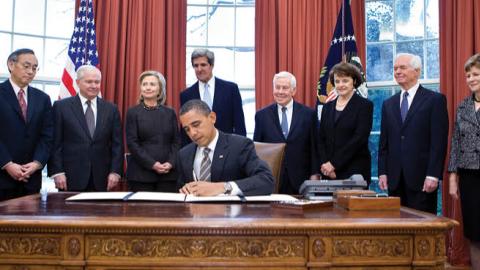Distrust between the United States and Russia grows and with it a fear of an arms race. As the February 2021 deadline for the expiration of the New START nuclear arms treaty approaches, a growing chorus of voices insist that President Trump should decide now to extend the treaty. But the causes of distrust between the two nations belie the wisdom in extending the treaty without conditions. For the president to make the decision now to extend the treaty for another five years, still almost 10 months from its deadline, would be to squander an opportunity to improve the agreement and American security.
Russia’s national objectives are to 1) establish an uncontested sphere of influence in the post-Soviet region now comprised of sovereign nations—nations that labor to live peaceably, responsibly, and free from Russian interference; and 2) to earn the reputation as a formidable power-broker able to contest U.S. influence and undermine U.S. interests all the way from Syria to Venezuela.1
Although the nations Russia has invaded—Georgia in 2008 and Ukraine in 2014– are not members of the NATO alliance, the United States has sanctioned Russia over its actions and has, to varying degrees across administrations, provided support to the invaded nations.
But the U.S. and international denunciations have not persuaded Russia to change its national goals or military strategies. To the contrary, Russia has exploited Cold War era arms control agreements to improve its military capabilities to better position Moscow to outmaneuver the United States and to threaten the viability of NATO.
Russia outright violated the Intermediate Nuclear Forces Treaty (INF) by deploying ground-based intermediate-range missiles. Neither the Obama nor Trump diplomats succeeded in persuading Moscow to comply, thus the Trump administration, with support from NATO, withdrew from the treaty.
The Russians are also straining the viability of the Open Skies Treaty,2 a treaty meant to foster trust between member nations by permitting unarmed overflights of their nations with surveillance planes. Unfortunately, the Russians are using the treaty as an instrument of distrust by prohibiting the United States to fly over certain parts of Russia, while they fly over nonmilitary areas such President Trump’s retreat in Bedminster, N.J—causing U.S. government officials to suspect Russia is using the treaty to extract valuable information about U.S. nuclear command and control.
This brings us to the New START Treaty (NST), signed by President Obama in 2010. The treaty seeks to cap both nations’ accountable strategic deployed nuclear weapons. Although this seems like it would ensure a modicum of parity at least with this category of weapons, due to the treaty’s counting rules, a bomber is counted as one weapon no matter how many nuclear bombs it carries. This permits greater uncertainty rather than clarity and demonstrates that New START’s much-vaunted “caps” on deployed strategic nuclear weapons really are not.
Moreover, the NST completely leaves out entire classes of nuclear weapons. Russia’s non-strategic nuclear forces outnumber U.S. nuclear weapons in the same category by a ratio of 10:1 and continue to grow unconstrained by arms control, which conveys a coercive advantage to Moscow in its foreign policy actions, especially in Europe. Simply extending New START without including these weapons eliminates any incentive for the Russians to negotiate limits.
And, the Director of the Defense Intelligence Agency Lt. General Ashley, told Hudson Institute on May 29, 2019, “The United States believes that Russia probably is not adhering to the nuclear testing moratorium in a manner consistent with the zero-yield standard.”3 The United States abides by a 1992 unilateral nuclear testing ban.
Russia is also modernizing and improving the weapons bound by the NST, and by its own admission, has completed modernization of 80 percent of its arsenal.4 In contrast, the United States has been slowly modernizing its force and the Trump modernization budget request to Congress, although what the nation needs, might not receive Congressional support.
Since the NST was implemented, the stability situation has deteriorated, rather than improved.
All the while China has risen as the most formidable threat to U.S. vital interests in the long term. Trump officials have been sounding alarm bells about the nature and trajectory of the Chinese nuclear weapons force, though China refuses to engage in any kind of strategic dialogue with other nuclear powers. Bringing China to the table to negotiate on nuclear arms is something the Russians have promoted. When NST was negotiated in 2013, Russian Deputy Foreign Minister Sergei Ryabkov insisted, “Making nuclear disarmament a multilateral process is becoming a priority.”5 The Russians should endeavor with the United States to make this happen.
The prudent path forward is for Congress to appropriate the funds the Trump budget requests for the nuclear deterrent, which will empower U.S. diplomats to engage Russia and China about nuclear arms. Even if China does not engage in time before the NST deadline, at the very least diplomats should work to negotiate an improved treaty that includes Russia’s exotic and non-strategic nuclear weapons and closes the counting loopholes inherent in the treaty. If Russia refuses to help engage China on its nuclear arms and refuses to constrain the weapons the United States finds most concerning, President Trump would be wise to let the treaty expire. The next president to take the helm can reengage and seek an agreement that makes sense for the increasingly complex and fraught nuclear weapons environment.



















